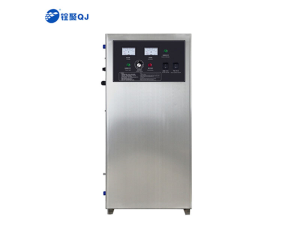According to the way of ozone generation, there are three main types of ozone generators at present: one is the high-voltage discharge type, the other is the ultraviolet irradiation type, and the third is the electrolysis type.
1. The high-voltage discharge generator uses a high-voltage current of a certain frequency to create a high-voltage corona electric field, which causes the oxygen molecules in or around the electric field to undergo electrochemical reactions to produce ozone.
This kind of ozone generator has the advantages of mature technology, stable operation, long service life, and large ozone output (single machine can reach 120Kg/h), so it is widely used in related industries at home and abroad.
The high-voltage discharge ozone generator is divided into the following types:
1. According to the generator's high-voltage electric frequency, there are three types: power frequency (50-60Hz), intermediate frequency (400-1000Hz) and high frequency (>1000Hz). Due to the disadvantages of large size and high power consumption, the power frequency generator has basically withdrawn from the market. The medium and high frequency generators have the advantages of small size, low power consumption, and large ozone output, and are very commonly used products now.
2. According to the gas materials used, there are two types: oxygen type and air type. The oxygen type is usually supplied by oxygen cylinders or oxygen generators. Air type usually uses air (such as compressed air) as raw material. Because ozone is produced by oxygen, and the oxygen content in the air is only 21/100, the concentration of ozone produced by air-type generators is relatively low, and nitrogen compounds are also derived. The oxygen purity of the bottled or oxygen generator is above 90/100, so the ozone concentration of the oxygen generator is higher. In environmental disinfection, air-type generators are usually used. In water treatment, priority should be given to oxygen-type generators. But if the generator needs to be used with the old ozone mixing tower when disinfecting drinking water, only the air type can be used.
3. According to the cooling method, there are water cooling type and air cooling type. When the ozone generator is working, it will generate a lot of heat energy and needs to be cooled, otherwise the ozone will be decomposed due to the high temperature. The water-cooled generator has good cooling effect, stable operation, no ozone attenuation, and can work continuously for a long time, but the structure is complicated and the cost is slightly higher. The air-cooled cooling effect is not ideal, and the ozone attenuation is obvious. Large generators or generators used in important places are usually water-cooled. Air cooling is generally only used for generators with small ozone output or places where generator performance requirements are not strict. When selecting generators, try to use water-cooled ones.
4. Divided by dielectric materials, there are several common types such as ceramic ozone tube, quartz tube, ceramic plate, glass tube and enamel tube. Among them, quartz tubes are often used by some high-performance ozone generators because of their high dielectric constant, uniform wall thickness, good ovality, high temperature resistance, and moisture resistance. The ceramic plate is easy to be brittle and only suitable for some small generators. The wall thickness and ellipticity of ceramic tubes are not easy to control, and the problem of uneven discharge is prone to occur, so they are not used much. Glass tube and enamel tube have low dielectric constant, poor high temperature resistance, and easy to burst. They are only used in some low-end generators.
5. According to the structure of ozone generating parts, there are two types: closed type and open type. The structural feature of the closed generator is that the sealed body itself is an electrode, and ozone can be used intensively, such as for water treatment. The electrodes of the open generator are exposed in the air, and the ozone produced cannot be used intensively, and is usually only used for air purification in a small space or surface disinfection of some small items. The closed generator can be used instead of the open generator. The cost of a closed generator is much higher than that of an open generator. It is worth noting that some people now rigidly encapsulate the open generator and pretend to be a closed generator. The result of this is that the large amount of heat cannot be dissipated in time, the ozone is attenuated seriously, and the generator is quickly burned.
2. Ultraviolet ozone generator uses ultraviolet rays with a specific wavelength (185mm) to irradiate oxygen molecules to decompose the oxygen molecules to produce ozone. Due to the large volume of the ultraviolet lamp, the low ozone output, and the short service life, this type of generator has a narrow range of use and is commonly used in disinfection cupboards.
3. Electrolytic generators usually produce ozone by electrolyzing pure water. The generator can produce high-concentration ozone water, has low manufacturing cost, and is simple to use and maintain. However, due to the shortcomings that the ozone output cannot be increased, the electrode life is short, and the ozone is not easy to collect, the scope of its use is limited. At present, this kind of generator is only used in some specific small equipment or in some specific places, and does not have the conditions to replace the high-voltage discharge generator.


